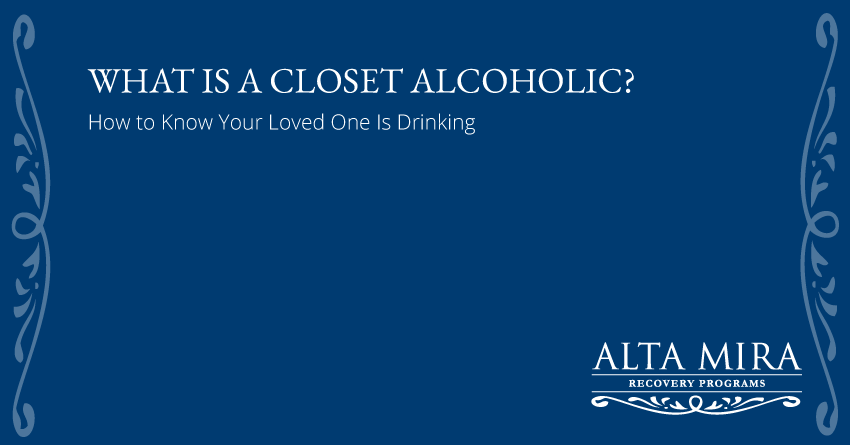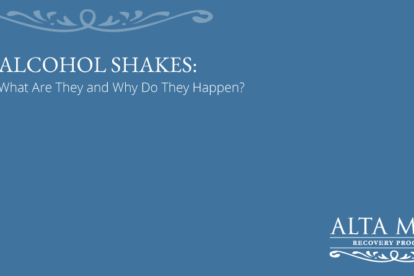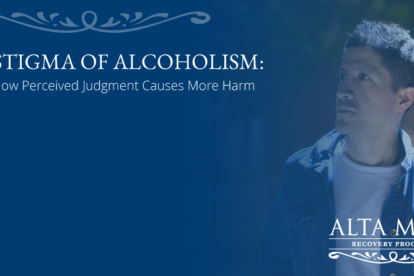What Is a Closet Alcoholic? How to Know Your Loved One Is Drinking

Alcohol is one of the most prevalent substances taken throughout the U.S. In Marin County, 19.3% of residents reported binge drinking during 2022. Those who binge drink are 14 times more likely to drive a motor vehicle while impaired, compared to those who do not.
Has your spouse ever come home seeming intoxicated? Do you worry they are driving or engaging in reckless activities while drinking? Do they deny they drink at all?
Alta Mira is comprised of multidisciplinary credentialed clinical teams that address and treat all aspects of alcohol use disorder. In this article, we discuss what a “closet alcoholic” is, and the characteristics behind this condition.
Definition and Characteristics of a “Closet Alcoholic”
Alcohol use disorder (AUD) is defined as a problematic pattern of alcohol use leading to clinically significant impairment or distress, according to the Diagnostic and Statistical Manual of Mental Disorders (DSM-5). It is subcategorized into mild, moderate, and severe based on the number of criteria met out of 11. While alcohol use disorder is the only medical term to describe the condition, there are socially accepted expressions utilized to label specific types of alcohol use.
The phrase “closet alcoholic” is both outdated and imprecise. Individuals experiencing alcohol use disorder exhibit diverse patterns of alcohol consumption and disclosure. While some openly display their drinking behaviors, others adopt varying degrees of concealment. Those described as “closeted” go to great lengths to hide their alcohol use from those around them, including intimate partners, colleagues, and family members.
Distinctions Between “Closet” Alcoholism and “High-Functioning” Alcohol Use Disorders
“Closet” and “high-functioning” alcohol use disorders are similar terms but represent distinct behavioral and psychological manifestations of AUD. “Closet” alcohol use disorder is characterized by a deliberate and intense effort to conceal alcohol consumption from others, driven by fear of stigma, judgment, or personal shame. Individuals with this condition take extreme precautions to hide their drinking habits, including consuming alcohol in private, discarding empty containers at the workplace or in neighboring waste receptacles, or disguising the appearance and smell of alcohol. The goal is complete secrecy, even from those closest to them.
The colloquial term “High-functioning” alcohol use disorder refers to individuals who maintain a facade of competence and normalcy in their personal and professional lives despite drinking to the point of being problematic. High-functioning individuals do not necessarily feel the need to hide their alcohol consumption, as they rely on their outward success or achievements to deflect criticism or concern. They may underestimate or rationalize the impact of their alcohol use, often dismissing it as manageable or insignificant. The primary distinction lies in the approach to visibility: those with “closet” AUD are deeply invested in keeping their alcohol use hidden while high-functioning individuals normalize or even boast about their consumption.

Identifying Indicators of "Closet" Alcoholism
Identifying “closet” alcohol use disorder poses challenges due to the deliberate efforts the person makes to conceal their behaviors. There are certain indicators suggesting the presence of an AUD to watch for. Physical signs, such as bloodshot eyes, unexplained tremors, or a noticeable odor of alcohol offer subtle clues. Additionally, behavioral changes, including sudden withdrawal from social interactions, excessive secrecy about daily routines, or a noticeable reluctance to engage in activities where alcohol is unavailable, raise a sign of concern.
Reasons behind the development of “closet” AUD span across different behaviors as well as emotional and mental factors. The following text dives into these categories.
Alcohol Consumption as a Coping Strategy
For many, alcohol consumption serves as a maladaptive coping mechanism to manage stress, anxiety, trauma, or other mental health discomforts. Those with “closet” AUD turn to alcohol as a means of escaping or numbing the difficulties they face in their personal or professional lives. The clandestine nature of their drinking intensifies this reliance, creating a vicious cycle where secrecy and consumption feed into one another.
One study highlighted limited evidence that utilizing drinking to cope with stress is more common in individuals with fewer adaptive coping skills. However, those who rarely utilized healthy coping strategies relied more heavily on alcohol as a way to manage stress. Participants with less adaptive coping skills were more likely to drink after a stressful situation, likely due to past experiences where drinking temporarily reduced negative emotions. This highlights the potential for over-reliance on alcohol as a learned coping mechanism when healthier alternatives are not utilized.
Behavioral Patterns: Concealment of Alcohol Use
Individuals managing “closet” alcohol use disorder exhibit distinct behavioral patterns centered around the concealment of their alcohol use. This behavior is meticulously planned and involves strategies to ensure that their drinking remains undetected. Consuming alcohol in isolated locations or using non-traditional containers to disguise their drinking is common. If their plan is disrupted or the likelihood of exposure increases, they experience heightened anxiety and reevaluate their course of action.
Another key behavioral pattern is the creation of plausible alibis or justifications for one’s actions. To avoid scrutiny, the person will fabricate stories about their whereabouts or engage in excessive secrecy about their schedules. When confronted, they may respond with heightened defensiveness or hostility if questioned, viewing questions as a threat to their carefully constructed facade.
Denial and Minimization of Alcohol Use
Denial and minimization are hallmark features of alcohol use disorder in general and specifically “closet” AUD. Both serve as psychological defenses to avoid confronting the reality of their behavior. Denial involves rejecting the notion that alcohol consumption is causing difficulties, often accompanied by justifications or rationalizations. Minimization, on the other hand, involves downplaying the extent or impact of their drinking.
Those with “closet” AUD may acknowledge their alcohol use but frame it as insignificant compared to others or suggest that they have it under control. These cognitive distortions allow individuals to maintain their drinking habits while avoiding the emotional discomfort of acknowledging their dependency.
A study utilizing information gathered from the San Diego Prospective Study (SDPS) compared two generations of participants with AUD. A large percentage of participants reported not qualifying for an AUD, despite alcohol consumption exceeding healthy amounts and matching 4 of the 11 criteria from the DSM-IV. They also gave misleading answers to alcohol consumption questions when asked by healthcare professionals. This highlights the need for specific approaches for those with AUD and denial.
Patterns of Heavy Alcohol Consumption
“Closet” alcohol consumption may take place in patterns ranging from moderate to heavy, though these patterns are carefully concealed. Binge drinking in private settings is a common behavior, allowing individuals to achieve the desired effects of alcohol without drawing attention. When faced with a social situation, they will consume beforehand and often come prepared with a way to drink secretly during the event.
These patterns can have significant physical and psychological consequences, including liver damage, cardiovascular complications, and poor mental health outcomes. The cycle of heavy drinking followed by periods of concealment also increases feelings of guilt and shame, further entrenching their reliance on alcohol as a coping mechanism. At this point, even “closet” alcohol consumption will begin to be more noticeable.
Interventions and Support Strategies for Loved Ones with "Closet" Alcohol Use Disorder
Intervening with someone managing a “closet” alcohol use disorder requires a nuanced and empathetic approach. Loved ones play a crucial role in facilitating acknowledgment and recovery, but understanding this condition must inform their efforts. Resources such as the alcoholism test, known as The Alcohol Use Disorders Identification Test (AUDIT), will aid in providing insight into behaviors and alcohol consumption.
An effective strategy is to create a safe and non-judgmental environment where the individual feels comfortable discussing their alcohol use. This involves expressing concern without assigning blame and avoiding confrontational language. Never refer to the person as an “alcoholic,” “addict,” or a “problem.” Speak with compassion and empathy.
Encourage professional support and provide time to look for resources. Programs involve extensive therapies, allowing the person to understand where their alcohol use disorder stems from and why they feel the need for secrecy. Family therapy also is beneficial in fostering open communication and addressing relational dynamics.

Getting Help for Alcohol Use Disorder in Sausalito, CA
Learning your loved one is managing a “closet” AUD can feel heartbreaking, and you wonder how you can help them get back on track. There is healing available through alcoholism rehab. During treatment, your loved one will receive extensive therapies and learn healthy coping skills to be utilized in the future. You are also an integral part of the recovery process, and family therapy will ensure you are involved every step of the way. Your loved one is still the same person you know and love – take the first step to leave alcohol out of the picture.
Having a loved one with a “closet” alcohol use disorder is devastating, but it doesn’t have to be a permanent part of your and your family’s life. Alta Mira provides evidence-based therapies in a peaceful and secluded setting, ensuring your family’s privacy during treatment. Our team of experts offers holistic techniques, providing a whole-person approach to care. Call us today at 866-922-1350 to learn more about our program offerings.
Alta Mira: Science-backed treatment, world-class care
Sources
Merrill JE, Thomas SE. Interactions between adaptive coping and drinking to cope in predicting naturalistic drinking and drinking following a lab-based psychosocial stressor. Addict Behav. 2013 Mar;38(3):1672-8. doi: 10.1016/j.addbeh.2012.10.003. Epub 2012 Oct 8. PMID: 23254217; PMCID: PMC3558592.
Schuckit MA, Clarke DF, Smith TL, Mendoza LA. Characteristics associated with denial of problem drinking among two generations of individuals with alcohol use disorders. Drug Alcohol Depend. 2020 Dec 1;217:108274. doi: 10.1016/j.drugalcdep.2020.108274. Epub 2020 Sep 10. PMID: 32956977; PMCID: PMC7736262.
“Alcohol Use and Your Health | Alcohol Use.” CDC, 14 January 2025, https://www.cdc.gov/alcohol/about-alcohol-use/index.html. Accessed 23 January 2025.
“Alcohol Use Disorder: A Comparison Between DSM–IV and DSM–5.” National Institute on Alcohol Abuse and Alcoholism (NIAAA), https://www.niaaa.nih.gov/publications/brochures-and-fact-sheets/alcohol-use-disorder-comparison-between-dsm. Accessed 23 January 2025.






